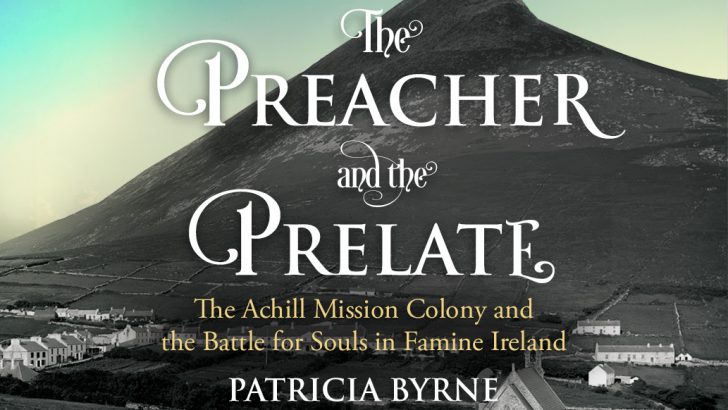The Preacher and the Prelate: The Achill Mission Colony and the Battle for Souls in Famine Ireland
by Patricia Byrne (Merrion Press, €14.99)
It is strange how the same place can have different effects on different people and at different times.
We recently reviewed a book on Achill Island as it appears today to a poet and a painter, John F. Deane and John Behan.
Their reactions were perhaps more insightful than those who think: “Oh, Achill is a lovely place.” So it is in July and August; how few outsiders go there in winter. In the mind’s eye, the almost perfect island created by the talent of Paul Henry dominates us all.
It was very different in the middle of the 19th Century. Then, it was a scene of famine, death, deprivation, and a sort of religious feud between John MacHale, the Catholic Archbishop of Tuam, and the Achill Island Mission, and its motivator Rev. Edward Nangle.
Patricia Byrne knows Mayo as a native, and has already published The Veiled Woman of Achill, about the criminal career of Lynchehaun.
The evangelical Protestant mission’s efforts on the island has been examined in the past, and remains controversial. It is great to have a new and up-to-date account, by an author who is able to draw on local lore as well archival materials.
She sees Nangle in his relations with the Catholic Archbishop, a difficult man to say the least, in a sort of socio-political standoff. This is a well-written book, which gives a clear, vivid account of the conflict, and of the doings of the mission.
To the national minded, like MacHale, the mission was seen as an assault on the Irish Catholic nation. They were angry that the mission should seduce the “simple peasants”, with the temptation of food and support. Yet there is a corollary to this: there seemed to be a denial of the right of the islanders to their own free expression of conscience.
But there is really no denying the neglect of the island by both the state and the Catholic Church. A small example: in the last decades of the century there was only one medical man, Cork-born Dr T. H. Croly, a protestant, resident in Dugout, who served the whole island and part of the mainland. Education too was a seriously defective.
Accounts
But there is also larger issue that has always struck me about the accounts of the mission which I have seen. Edward Nangle, it seems to me, was a driven man. Archbishop MacHale had an eye on the future, on the maintenance of the Catholic Church in the west. But for Edward Nangle there was to be no future.
He was an intense student of the Book of Revelation. He believed that the signs of the times indicated that the end of the world, Armageddon and the Last Judgement, were immediately immanent.
Pages of his Achill Island Herald, which circulated largely among his supporters at Exeter House and across Great Britain, were devoted to discussing the French Emperor Napoleon III as the Anti-Christ.
Nangle thoughts were summarised in The Apocalypse Explained, first published in March 1859. My copy of the 2nd edition of 1877 carries an affection dedication indicating its influence. By that date Nangle was safely ensconced in Rathmines, far from the bleak acres of the Achill.
But his vision of Armageddon, the last battle of Good against Evil, taking place on those barren western hills, has always seemed to me to explain, in a deeper, personal way, just what went into his struggle with the Catholic authorities. Historians should take his theology seriously as MacHale’s.
His greatest desire was the save the western peasants from total perdition and eternal damnation, a powerful motive for caritas. The influence of St John on his mind has never been quite understood, even though his memorial in the little Church at Dugort appeals to Revelations 14:13.
MacHale died in 1881, Nangle in 1883. Things began to change for the island when the railway reached Achill Sound in May 1895.
But the tourists who crowded in for the shooting, fishing and seaside sports mostly stayed at Captain J. R. Sheridan’s popular Dugort Hotel, a creation of the Achill Mission.
Bleak Slievemore, Nangle’s heights of Megiddo, on which the final conflict of the world could have been envisaged, became for some a demi-paradise.


 Peter Costello
Peter Costello
